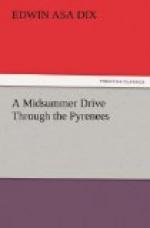As we descend to the carriages, facing another tall Pic which shoots up from the farther side of the col, the sun has neared the clouds in the west; it strikes the far-off Maladetta glaciers with a light no longer white, but rose-tinted; the snows glow softly under it like fields of tremulous flame; the mountains gleam almost as something supernal, as we take a final gaze before turning away down the valley.
IV.
It is the last of our midsummer drive through, the Pyrenees. We realize it almost suddenly, and with regret. We seek to absorb and enjoy every minute as we drive down the long hills and on through the Vale of Campan in the evening light toward Bigorre. It is a chaotic, delightful array of memories that our minds are whirling over and over in their busy hoppers,—incidents and scenes, grains of legend, kernels of history, gleanings of quick, nearer life,—all the intermingled associations now sown for us over the region.
Instinctively we summon up recollections of the Alps for comparison with the mountains we are leaving. And the comparison is not found to be entirely a sacrilege. The Alps are first and preeminent among European mountains; the repose of their immensity, the sense of power, the indefinable, spell they exert, lesser ranges cannot in general features attempt to rival. But this is not to say that a lesser range, is a wholly inferior range,—that even in this effect of immensity, of power, it may not at certain points bear almost full comparison. The Pyrenees, we agree, are far from lacking material for a parallel. As we think of the briefly glimpsed cliffs of the Pic du Midi d’Ossau, or of the ice-fields seen about the Balaitous, the Vignemale, the Taillon, the Crabioules, we set them in thought almost against the crags of the Mont Cervin, or the Eismeer and the glaciers of the Bernina. We instance, as Alpine impressions, the prospects, among others, from the Aubisque and the Entecade; the snow-peaks, named and unnamed, in their sight, the heights and depths revealed by the view. We traverse again the gorges leading to Eaux Chaudes and Cauterets, and the winding road through the Chaos; we confront the amazing wall of the Cirque




